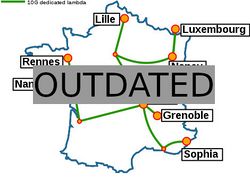Grid5000:Home: Difference between revisions
No edit summary |
No edit summary |
||
| (3 intermediate revisions by 2 users not shown) | |||
| Line 4: | Line 4: | ||
|bgcolor="#f5fff5" style="border:1px solid #cccccc;padding:1em;padding-top:0.5em;"| | |bgcolor="#f5fff5" style="border:1px solid #cccccc;padding:1em;padding-top:0.5em;"| | ||
[[Image:renater5-g5k.jpg|thumbnail|250px|right|Grid'5000]] | [[Image:renater5-g5k.jpg|thumbnail|250px|right|Grid'5000]] | ||
'''Grid'5000 is a large-scale and | '''Grid'5000 is a large-scale and flexible testbed for experiment-driven research in all areas of computer science, with a focus on parallel and distributed computing including Cloud, HPC and Big Data and AI.''' | ||
Key features: | Key features: | ||
* provides '''access to a large amount of resources''': | * provides '''access to a large amount of resources''': 15000 cores, 800 compute-nodes grouped in homogeneous clusters, and featuring various technologies: PMEM, GPU, SSD, NVMe, 10G and 25G Ethernet, Infiniband, Omni-Path | ||
* '''highly reconfigurable and controllable''': researchers can experiment with a fully customized software stack thanks to bare-metal deployment features, and can isolate their experiment at the networking layer | * '''highly reconfigurable and controllable''': researchers can experiment with a fully customized software stack thanks to bare-metal deployment features, and can isolate their experiment at the networking layer | ||
* '''advanced monitoring and measurement features for traces collection of networking and power consumption''', providing a deep understanding of experiments | * '''advanced monitoring and measurement features for traces collection of networking and power consumption''', providing a deep understanding of experiments | ||
Revision as of 00:57, 12 February 2020
|
Grid'5000 is a large-scale and flexible testbed for experiment-driven research in all areas of computer science, with a focus on parallel and distributed computing including Cloud, HPC and Big Data and AI. Key features:
Grid'5000 is merging with FIT to build the SILECS Infrastructure for Large-scale Experimental Computer Science. Read an Introduction to SILECS (April 2018)
Older documents:
|
Random pick of publications
Five random publications that benefited from Grid'5000 (at least 2517 overall):
- Amélie Aussel, Radu Ranta, Olivier Aron, Sophie Colnat-Coulbois, Louise Tyvaert, et al.. Cell to network computational model of the epileptic human hippocampus suggests specific roles of network and channel dysfunctions in the ictal and interictal oscillations. Journal of Computational Neuroscience, 2022, 50 (4), pp.519-535. 10.1007/s10827-022-00829-5. hal-03721996 view on HAL pdf
- Ali Tehranijamsaz, Mihail Popov, Akash Dutta, Emmanuelle Saillard, Ali Jannesari. Learning Intermediate Representations using Graph Neural Networks for NUMA and Prefetchers Optimization. IPDPS 2022 - 36th IEEE International Parallel & Distributed Processing Symposium, May 2022, Lyon / Virtual, France. hal-03603118 view on HAL pdf
- Manuel Alejandro Diaz-Zapata, Özgür Erkent, Christian Laugier, Jilles Dibangoye, David Sierra González. LAPTNet: LiDAR-Aided Perspective Transform Network. ICARCV 2022 - 17th International Conference on Control, Automation, Robotics and Vision, Dec 2022, Singapore, Singapore. hal-03851513 view on HAL pdf
- Nicolas Zampieri, Carlos Ramisch, Irina Illina, Dominique Fohr. Identification of Multiword Expressions in Tweets for Hate Speech Detection. LREC 2022 - 13th Edition of its Language Resources and Evaluation Conference, Jun 2022, Marseille, France. hal-03676508 view on HAL pdf
- John Baena, Pierre Briaud, Daniel Cabarcas, Ray Perlner, Daniel Smith-Tone, et al.. Improving Support-Minors rank attacks: applications to GeMSS and Rainbow. CRYPTO 2022 - 42nd Annual International Cryptology Conference, Aug 2022, Santa Barbara (CA), United States. pp.376--405, 10.1007/978-3-031-15982-4_13. hal-03533455v2 view on HAL pdf
Latest news
Failed to load RSS feed from https://www.grid5000.fr/mediawiki/index.php?title=News&action=feed&feed=atom: Error parsing XML for RSS
Grid'5000 sites
Current funding
As from June 2008, Inria is the main contributor to Grid'5000 funding.
INRIA |
CNRS |
UniversitiesUniversité Grenoble Alpes, Grenoble INP |
Regional councilsAquitaine |


